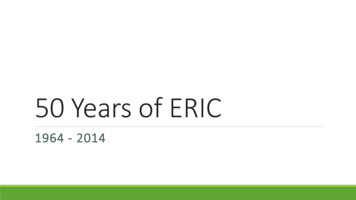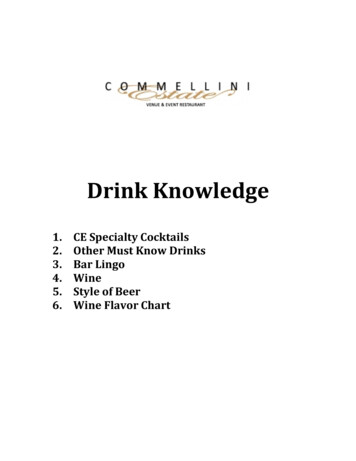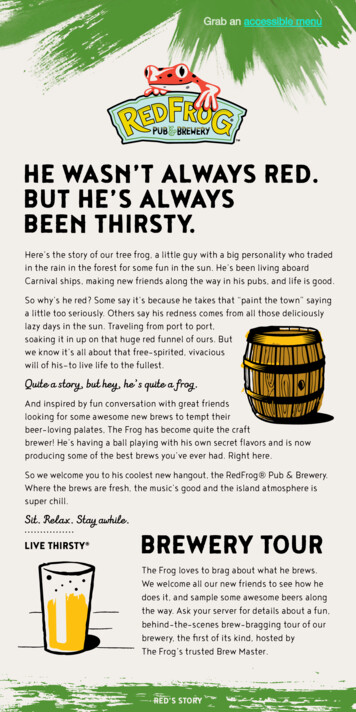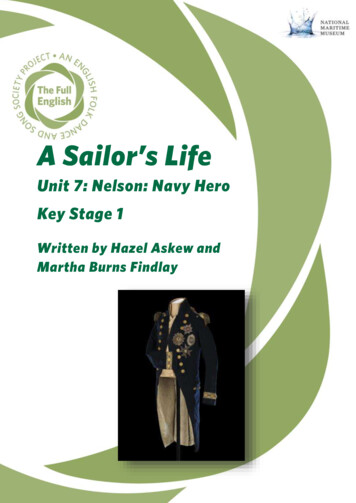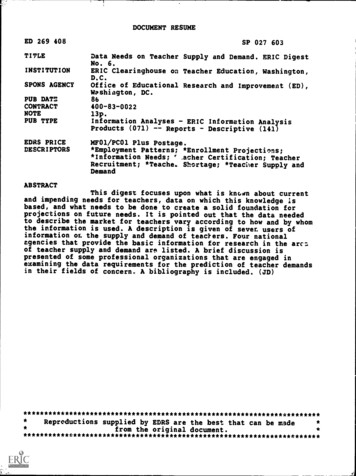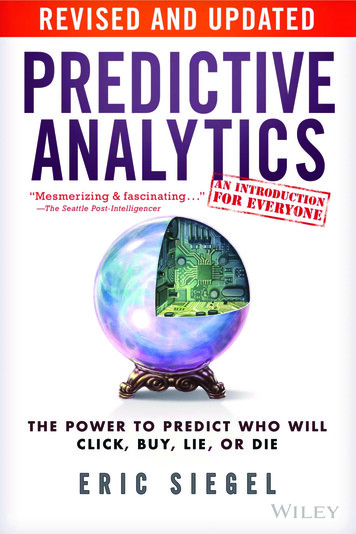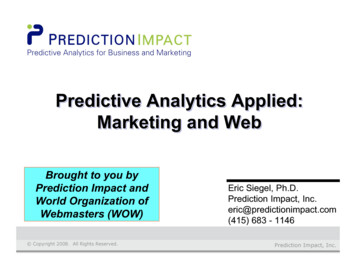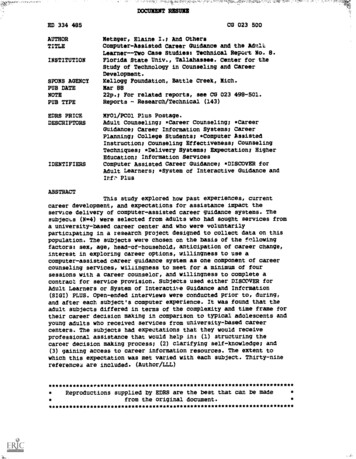
Transcription
'e?DOCUMENT RUMED 334 485AUTHORTITLEINSTITUTIONSPONS AGENCYPUB DATENOTEPUB TYPEEDRS PRICEDESCRIPTORSIDENTIFIERSCG 023 500Metzger, Elaine I.; And OthersComputer-Assisted Career Guidance and the Adnlk.Learner--Two Case Studies: Technical Report No. B.Florida State Univ., Tallahassee. Center for theStudy of Technology in Counseling and CareerDevelopment.Kellogg Foundation, Battle Creek, Mich.Mar 8822p.; For related reports, see CG 023 498-501.Reports - Research/Technical (143)XF01/PC01 Plus Postage.Adult Counseling; *Career Counseling; *CareerGuidance; Career Information Systems; CareerPlanning; College Students; *Computer AssistedInstruction; Counseling Effectiveness; CounselingTechniques; *Delivery Systems; Expectation; HigherEducation; Information ServicesComputer Assisted Career Guidance; *DISCOVER forAdult Learners; *System of Interactive Guidance andIrf: PlusABSTRACTThis study explored how past experiences, currentcareer development, and expectations for assistance impact theservace delivery of computer-assisted career guidance systems. Thesubjecus (N 4) were selected from adults who had sought services froma university-based career center and who were voluntarilyparticapating in a research project designed to collect data on thispopulation. The subjects were chosen on the basis of the frAlowingfactors: sex, age, head-of-household, anticipation of career change,interest in exploring career options, willingness to use acomputer-assisted career guidance system as one component of careercounseling services, willingness to meet for a minimum of foursessions with a career counselor, and willingness to complete acontract for service provision. Subjects used either DISCOVER forAdult Learners or System of Interactive Guidance and Information(SIGI) PLUS. Open-ended interviews were conducted prior to, during,and after each subject's computer experience. It was found that theadult subjects differed in terms of the complexity and time frame fortheir career decision making in comparison to typical adolescents andyoung adults who received services from university-based careercenters. The subjects had expectations that they would receiveprofessional assistance that would help in: (1) structuring thecareer decision making process; (2) clarifying self-knowledge; and(3) gaining access to career information resources. The extent towhich this expectation was met varied with each subject. Thirty-ninereference3 are included. ********************************Reproductions supplied by EDRS are the best that can be madefrom the original ******************************
aComputer-Assisted Career Guidance and the Adult Learner - TwoCase Studies: Technical Report No. 8byElaine I. MetzgerJames P. Sampson, Jr.Robert C. ReardonUI DEPASTMENT Dr EDUCATIONOtt.ce of LetucatPonar Resayrn and imprmermenrEDUCATIONAL RESOURCES INFORMATIONCENTERIERIOMarch, 1988-PERMISSION TO REPRODUCE THISMATERIAL HAS BEEN GRANTED BYJOire51rI4 docwmant hat Deer reprodvca0 atPof4r sirreCe.vrel from Me perip.On or eg9arlds1.0,1orlafin .1C Mirror ChilirVet have berm made to rhtydve,aprOClixtion gualdyPamt of w,eeoPowra Stated,' tn.sClocumerit C1,0 nOt neCeIliIrdy retprelsent ott,C.alDER! PoArt,on of policyTO THE EDUCATIONAL RESOURCESINFORMATION CENTER (ERIC)Project LEARNCenter for the Study of Technology in Counselingand Career DevelopmentDepartment of Human Services and Studies215 Stone BuildingThe Florila State UniversityTallahassee, Florida 32306-3001C)C)NNcy0CiaElaine I. Metzger is a Research Associate, James P. Sampson,Jr. is an Associate Professor, and Robert C. Reardon is Professorin the Department of Human Services and Studies. The second andthird authors also co-direct the Center for the Study ofTechnology in Counseling and Career Development at Florida StateUniversity. We would like to thank JoAnn Harris-Bowlsbey of theAmerican College Testing Program and Lila Norris of theEducational Testing Service for their assistance in thecompleticn of this research. Support for this investigation wasprovided by a grant from the W. K. Kellogg Foundation throughProject LEARN.BEST COPY AVAILABLE
Table of ContentsagAAbstractBackgroundPurpose of the StudyMethodologyQualitative ApproachSelection of SubjectsProceduresStructure of the InterviewsResultsThe Case cf JoyceThe Case of AnnDiscussionImplications for PracticeImplications for Future ResearchReferences1233344510141516173
1AbstractThe decision to seek career counseling services as an adultarises from a complex interaction of past experiences, currentcareer development, and expectations for assistance. This studyexplored how these multiple motivations impact the servicedelivery of computer-assisted career guidance systems. Thesubjects were selected from adults who had sought services from aaniversity-based career center and who were voluntarilypaicipating in a research project designed to collect data onthis population. The subjects selected for this qualitativecomponent of the study were chosen on the basis of the followingfactors: sex, age, head-of-household, anticipation of careerchange, interest in exploring career options, willingness to usea computer-assisted career guidance system as one component ofcareer counseling services, willingness to meet for a minimum offour sessions with a career counselor, and willingness .4x)complete a contract for service provision. The study wasintended as a process of exploration and discovery. As such,open-ended interviews were conducted prior to, during, and aftereach subject's computer experience.It was found that the adult subjects participating in thisqualitative study differed in terms of the complexity and timefram, for their career decision making in comparison to "typical"adolescents and young adults who receive services fromuniversity-based career centers. The subjects had expectationsthat they would receive professional assistance that would helpin: 1) structuring the career decision making process; 2)clarifying self-knowledge; and 3) gaining access to careerinformation resources. The extent to which this expectation wasmet varied with each subject. Implications for practice and forfuture research have been presented to stimulate furtherexploration in this area of career guidance for adults.
2BackgroundOver the past twenty years a consensus has emerged amongpractitioners and researchers that adults have career guidanceneeds different from adolescents and young adults. As a resultof changes in the economy, the labor market, and the family,adults are increasingly facing issues such as mid-life careerchange (Leibowitz & Lea, 1986; Zunker, 1986; Brown, 1984; Gysbers& Assoc., 1984; Herr & Cramer, 1984; Okun, 1984; and Aslanian &Brickell, 1980), dual-career couples (Sekaran, 1986; Gilbert,1985; Miller, 1984; Pepitone-Rockwell, 1980; Bryson & Bryson,1978; and Rapoport and Rapoport, 1976) and women returning toeducation and work after a long absence (Betz & Fitzgerald, 1987;Metzger, 1986; Diness, 1981; Berman, 1980; and Burack, Albrecht &Seitler, 1980).In response, a variety of services and resources have beendesigned to meet the career guidance needs of adults (Johnson &Pyle, 1984; Herr & Cramer, 1984; Sampson, Shahnasarian & Maddox,1984; and Maze & Cummings, 1982). A recent innovation hasinvolved the development of computer-assisted career guidance(CACG) systems for adults. Two types of systems currently exist.The first is primarily designed to be used in an educationalcontext and is most often found in community colleges,universities, vocational technical schools, and adult educationcenters. Examples include DISCOVER for Adult Learners (AmericanCollege Testing Program, 1986) and FIGI PLUS (Educational TestingService, 1986). The second type of system is primarily designedto be used in an employment context and is most often found inbusiness and industry settings (Shahnasarian, 1987).Examplesinclude DISCOVER for Organizations (American College TestingProgram, 1986) and CareerPoint (Conceptual Systems, 1986).Due to the recent emergence of CACG systems designed foradults, research on the effectiveness of these computerapplications is limited. The data that does exist involvedevaluating adults" use of CACG systems originally designed forhigh school and college students. Chapman and Greenberg (1985),Splete (1984), and Splete, Elliott, and Borders (1985) reportpositive adult user reaction to using the DISCOVER system(American College Testing Program, 1984). Marin (1984) foundthat adults using DISCOVER showed improvements in decision-makingcommitment and certainty, as well as decidedness. The abovestudies, however, have two important limitations. First, the useand impact of adult versions of CACG systems have not beenstudied. Second, the vast majority of CACG research isquantitative in nature, and the type of data obtained are limitedby the constraints inherent in objective measures and the datareduction inherent in statistical analysis.In view of the recent availability of adult versions of CACGsystems and the limited research dazta available, an exploratoryresearch methodology is needed. Specifically, a need exists tomore fully understand and document the interaction between the
mt.",3characteristics of adults and the capabilities of computerassisted career guidance services. Data from this type ofresearch can aid practitioners in designing computer-assistedcareer guidance services to more effectively meet the needs ofadults and aid researchers in formulating hypotheses for futureinvestigations.Purpose of the StudyThis study was designed to qualitatively explore how adults'past experiences, current career development, and expectationsfor assistance impact computer-assisted career guidance servicedelivery.MGthodologyOualit4t1ve ApproachA qualitative methodology was selected as a logical startingpoint for exploratory research. Alexander (1980) notes: ".therichness of the texture of one's life tends to be lost inmethodologies that use such operations as ordering, quantifying,and prepared questionnaires" (p. 18). The decision to undertakethese case studies grew out of a recognition that numeroussociological, economic, technological, and psychological factorsaffect career decisions for adults. These multiple motivationsinclude pressures from the environment as well as pressures fromself (Aslanian & Brickell, 1980). Pedro (1983) suggests thatcareer change occurs in relation to antecedent experiences andfuture alternatives, and she advises exploring the interactionbetween career choice and the domains of life: family, society,Career decision making is a continuous,and recreation.tentative, and often not a very logical process (Osipow, 1983;Fredrickson, 1982; and Sher, 1979). Therefore, is best examinedas a process rather than as mutually exclusive independent anddependant variables. Yin (1984) refers specifically to the casestudy as the research strategy which "allows an investigation toretain the holistic and meaningful characteristics of real-lifeevents--such as individual lifecycles." (p. 14).Selection of SubjectsSubjects for this study were selected from adults whovoluntarily sought services from a university-based careercenter. A career center staff member assisted each adult seekingservices to identify their needs and select appropriateIn situations where career counseling wasinterventions.appropriate, adults were given the option of participating in aneval.ative research project. The initial counseling sessionincluded the collection of demographic information and a detailedexplanation of the purpose of the study and the data collectionprocedures. Of the 89 adults who participated in the researchproject, four were selected for participation in a qualitativecomponent of the study on the basis of the following factors:
41)2)3)4)5)6)sex (equal balance of men and women);age (midlife - between 30 and 50);head-of-household;the anticipation of some type of career change;an interest in exploring career options;willingness to use a computer-assisted career guidancesystem as one component of career cfmnseling services;7) willingness to meet for a minimum o. four sessions with acareer counselor; and6) willingness to complete a contract for service provision.Of the four adults, two were White males and two were Whitefemales, ranging in age from 34 to 41, with a mean age of 36.One man and woman were assigned to DISCOVER for Adult Learnersand one man and woman were assigned to SIGI PLUS. Two of thefour subjects completed their participation in the study, until amutually agreed upon termination. One of the men dropped out ofthe study because of a sudden job reassignment in another part ofthe country. The other man became involved in divorceproceedings and decided to remain in his current job and seekcareer counseling services at a later date.ProceduresEach adult completed a research participation release formprior to data collection indicating they were aware that noteswould be taken during sessions, that all information would bekept confidential, and that actual names would not be used in anyresearch reports or staff case conferences. Two-hour sessionswere scheduled to use the computer assisted guidance systems oncea week for three consecutive weeks. The four interviews with thecareer counselor were held both during and after their computerexperience at a time and place convenient to the participant.In addition to career counseling and the computer-assisted careerguidance systems, each adult was encouraged to use the printbased and audio-visual career information resources available inthe center. Adults were asked to use only the computer-assistedcareer guidance systems to which they had been assigned (eitherDISCOVER for Adult Learners or SIGI PLUS) until after thecompletion of the study.Structum of the InterviewsThe focus of the interviews was to gather each adult'sperception of personal and family career-related experiences thats/he was able to recall and chose to share. The participantswere asked to discuss their current work situation as well astheir occupational daydreams. They were encouraged to sharetheir stories as they wished, without r!oncentrating on achronological time frame presentation. Open-ended interviewswere used to facilitate that process. The experiences of theadults in receiving prior career counseling services were alsonoted as the study progressed.
5Two approaches were used to collect data through the openended interviews: 1) the informal conversational interview; and2) the general interview guide approach. Patton (1980) notesthat the diA!ference between these two approaches is the extent towhich the questions are determined before the interview. Withthe informal conversational interview, the spontaneity of thenatural flow of an interaction provides the basis of the data.The beginning of each session was based on this informalconversational approach.If one of the adults seemed "stuck,"and/or if particular topics from the case study notes neededclarification or expansion, the career counselor would askspecific questions. The interview guide presumed that there wascertain common information needed from each adult, and it servedas a checklist to help the interviewer obtain similar data fromeach adult participating in the study. The interview guideconsisted of questions in general career-related areas: Whatpast experiences may have served to shape your career path? Whatfactors are influencing your present career exploration? Whatexpectations brought you to the career center? What interactionsaffected your experience at the Career Center? Both the aboveopen-ended approaches support Patton's (1980) principle thatinterviewing provides, "a framework within which respondents canexpress their own understandings in their own terms" (p. 205).By the end of the interview sessions, data had been obtainedfrom each subject about career-related events and experiencesfrom childhood, adolescence, young adulthood, and adulthood.Inaddition, a sense of the personal and emotional issuesconfronting each adult was obtained.Results - The Case of Joycebackground InformationJoyce is a 36-year-old White female who grew up in New YorkCity with her parents and an older sister. Her father was anelevator operator and her mother was employed as a secretary.Joyce described her home life as having been "very unstable,"with an alcoholic father who both physically and emotionallyabused his wife and daughters. She was determined from early inher life to "move ahead" and saw education as her "way out."Although her grades in high school were mediocre, Joyce had acollege degree as her goal. She was accepted into a small,private college in a nearby town. However, when she asked herfather for the money he had promised would be available for nereducation, she learned that he had used it to support his alcoholdependency. Joyce was both extremely disappointed and veryHer anger made her even more determined to find a way toangry.She enrolled as a part-time student in a localgo to college.community college and worked part-tiro to support herself.After several years, Joyce married, moved, and gave birth toa daughter. During this period, she continued to attend schoolen a part-time basis and received her bachelor's degree insociology after nine years. After graduation Joyce accepted an
6administrative position in a social service agency. Shethorouahly enjoyed her work; however, after several months shewas laud off due to a funding Qutback.During this period, bothJoyce and her husband were drinking heavily.Partly due to thisproblem ex well as to her husband's unwillingness to seekcounseling, Joyce made the decision to seek a divorce. Afterseveral months of unemployment, Joyce accepted a position as acaseworker, only, she said, because she "did not have the luxuryof looking around for a more satisfying job." She did not enjoyher job, was not happy with herself, and felt quite depressed.Shortly thereafter she remarried. Joyce quit her job almostimmediately. In facc, she indicated that one reason for marryingagain was so that she would not have to work outside the home.At the same time, due to their financial situation, Joyce didhold a variety of part-time and temporary positions for the nextseveral years.presen ZituationJoyce initially came to the Career Center for advice aboutcareer options and help in identifying her skills and interests.She expressed boredom and frustration with her secretarialposition and, at the same time, a need for a full-time job.Joyce WAS separated from her second husband at this time and wasinitiating divorce proceedings when she first came to the center.She had responsibility for two children, a fourteen-year-olddaughter from her first marriage, and a three-year-old daughterfrom her present marriage.Joyce had completed a four-year liberal arts college degree.In exploring her career options, she was interested in learningwhat areas would be available without further schooling as wellidentifying options which might require additional formaleducation. She said she would return to school only if it wasnecessary to pursue a particular career.Joyce learned about the services available at the careerInitially,center through another counselor she was seeing.Joyce was reisarved and reluctant to share much about her personalsituation (even though she had readily volunteered to participatein the study).She had been through a vocational assessmentseveral years earlier while attending a community college and hadfound it helpful. It was this previous experience that led herto seek assistance at the center.Joyce was very task-oriented and, after her initial meetingwith the counselor, would regularly call and schedule computerShe spent approximately six hours (over four sessions)time.interacting with SIGI PLUS before requesting a second appointmentwith the counselor. During the interim, the counselor would"check in" with her, but Joyce said she was not ready to meetyet. At the second interview, she had specific questions abouther printout and also wanted further information on occupationalareas that had particularly interested her.
7She expressed frustration because she was personallyinterested in finding an occupation which provided an opportunityto interact with people. However, the data she inputted intoSIGI PLUS identified "working with data" as a strength for her,while she scored low in "working with people." While Joycerecognized that she had strong organizational skills and afacility to work with computers, she was interested in a careerin which she would also be able to use her creativity.Creativity, security, stability, and helping others were highvalues for Joyce.The counselor made print-based media resources available toJoyce, and she explored particular areas in more depth.Inaddition, the counselor discussed using informational interviewsas a strategy to gain more data. At this second meeting, Joycewas more relaxed and willing to share personal information.Joyce spent the next few weeks reviewing her SIGI PLUSprintout results, doing informational interviews, and continuingher interaction with SIGI PLUS. She spent a total of ten hourson SIGI PLUS. At that time she completed the forms necessary todocument her participation in the study. Joyce then asked if itwould be possible for her to interact with DISCWER for AdultLearners.(In a later interview with the counsalor, sheindicated she had found the syszems comparable, although shefound the World-of-Work Map in the DISCOVER system "somewhatconfusing and limiting."To date, Joyce has spent twenty hours utilizing the servicesat the career center, inc;luding SIGI PLUS, interviews with acounselor, printed resources, and DISCOVER for Adult Learners.She has also spent numerous hours conducting informationalinterviews.She stated that she has been pleased and se.isfiedwith the resources and activities available to assist her careerplanning.Joyce's persistence and readiness to devote time and energyto the career exploration process facilitated her career changedecision.She called two weeks after her final session to saythat, after numerous informational interviews, she had decided toenter the landscape design program at a local university. Sheplanned to enroll on a part-time basis while continuing to workfull-time. She has shared her plans with her present employer,who is willing to arrange a flex-time schedule for her.Joycealso said she would explore financial aid options which mayenable her to eventually return to school nn a full-time basis.Joyce stated that her interactions with the computer-assistedguidance systems, as well as the personal attention by the careercounselor, gave her both the information and the confidence sheneeded to take steps toward making a career change. Joyce wasexcited about her decision and said: "I just wanted to call andlet you know, because your support and help were so important inhelping me make my decision."0
8Responses to Specific Ouestione1)lit-.h.1f.A.;.career path?Joyce indicated that her father was the strongest influencein shaping her career path. As a result of his alcoholdependency, Joyce did not have financial support to attendcollege and it took nine years of combining work and schoolbefore she received her degree. Furthermore, Joyce did notreceive emotional support for her desire to gat a college degree;her father believed that "a woman's place is in the home." Thislack of financial, as well as emotional support, perpetuated lowself-confidence. She noted that one outcome of this has beenthat she has not typically sought positions comparable to hereducational background. Joyce had little confidence in herselfor her abilities when making her early career choices.After leaving home, Joyce assumed more responsibility forher life decisions. For example, she said that recognizing herown alcohol dependency, and dealing with it through AlcoholicsAnonymous, made her more aware of personal strengths and skills.Still, however, Joyce had in mind her father's message that shewould marry and have someone take care of her. Joyce said sheexpected that in both her marriages. She now realizes that shecan only depend on herself, and that if she does marry again, shewould not be willing to become completely dependent on a spouse.She said she has grown up and recognized that she would want tokeep a better balance between marriage, family, work, recreation,and community activities.2) Wbat factors Are influencing Yollr RMAJA-RAZ2 exploration?reeling unhappy and dissatisfied on a day-to-day basis withher present job brought Joyce to the point of recognizing she wasShe knew she had the skills and capabilitiesready for a change.to be doing more and expressed a desire to feel chal3enged by herwork. Prior to coming to the career center, Joyce spent timereflecting on what she wanted and was not getting from a job.The main frustration she expressed was the lack of creativity inher secretarial position. She recognized that a simple jobchange would not be satiqfying and that, in fact, she needed anew career direction. Sne wanted more opportunity for personalinteraction and a greater sense of accomplishment in her job.Another influence on her decision to explore a new careerdireccion was Joyce's realization that she could not count oneither of her former husbands for child support and that she wasunable to provide comfortably for her two children and herself onher present salary.3) What exvectations brought you to the career center?Joyce initially came to the career center because of apositive experience she had previously had with vocationalassessment at a community college. She realized that she was atanother cross-road in her life and was experiencing a need to bemore emotionally and financially self-sufficient. Joyce came to
9the center for support as she went through the process ofclarifying her career direction. She was aware of some of herskills, such as a facility for organization and working withJoyce wasdetails, good writing skills, and pride in her work.particularly interested in incorporating her creative skills intoFor example,a career, yet was uncertain how to combine the two.Joyce enjoyed landscaping her yard, decorating her home, andworking with crafts, and wanted to find a way to incorporatethose interests into her work.Joyce said she wanted specific information that would helpher answer questions such as: What am I good at? What do Ilike? How much money is available in a field? How likely is itthat I will find a job in a particular area? She also wantedhelp in identifying resources, such as filancial aid, that mightbe available to her. Joyce was also looking for emotionalsupport since she often underestimates herself and needed"someone from outside myself to help me see myself more clearly."Joyce knew the process would not be easy and that "whilechange is good, it is also very painful." She was willing toassume responsibility for herself and expressed a desire to "workas hard and as long as I need to" to expand her options.vour exp4)center?Joyce stated that her experience at the career center waspositive and that she received the support and assistance sheneeded to clarify her career direction. She noted that the SIGIPLUS print-out was useful because she was able to review it onher own time, and then return to the center for more specificinformation from SIGI PLUS, as well as from other print-basedresources. Joyce said that meeting individually with a counselorand participating in the qualitative research study added animportant dimension to her career exploration because it providedan opportunity for her to clarify her goals by talking aboutthem: "Sharing my story and my goals helped me figure out who Iam and where I'm going." Another strategy of particular valuewas the informational interview--which she used extensivelybefore making her decision. Joyce also identified a frustrationabout visiting the career center during the day "when there wasso much activity and where I felt uncomfortabll with the'younger' counselors."Joyce was feeling personally pressured to "move on," not somuch out of her present job, as out of her secretarial "mode."That pressure at times seemed to make her anxious to have all theanswers immediately, even though she was aware that careerexploration is a process that takes time and emotional energy towork through.12
10Results - The Case of Annbackground InformationAnn is a 30-year-old White female who was raised in a smallMississippi town with four brothers and sisters. Her father wasa tenant farmer who held various odd jobs to support his family.Ann described her father as "very intelligent, even though he hadno formal schooling past the eighth grade." She saId her mother"never did much of anything, except complain."Formal education was not perceived as important by herparents and was not encouraged; in fact, two of her brothers didnot finish high school. At the same time, Ann noted that fromthe time she was four years old, she had a "burning desire toknow things," and she dreamed of someday going to college. Annwas the first in her family to attend college. She did notreceive financial support from her family for her collegeeducation. Ann indicated that her mother opposed her decision toattend, while her father was noncommittal when she announced sheShe felt that neither parent understood her desire towas going.continue with school.Ann said she never really fit in, either at home or atShe described herself as a "difficult teenager," sayingshe was a loner and often depressed. She spent much of her timereading and said she was "always in trouble" with her motherbecause she would hide in the trees with a book instead of doingher chores around the farm. At the same time, Ann was on severalsports' teams and was her high school class president. Whenasked about th
future research have been presented to stimulate further. . needs different from adolescents and young adults. As a result of changes in the economy, the labor market, and the family, adults are increasingly facing issues such as mid-life career . 1984; Okun, 1984; and Aslanian & Brickell, 1980), dual-career couples (Sekaran, 1986; Gilbert .

